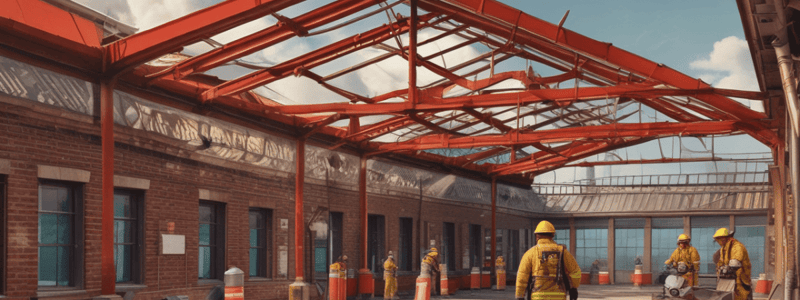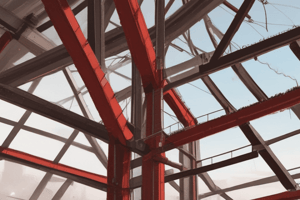Podcast
Questions and Answers
What is a key design feature of flat roofs?
What is a key design feature of flat roofs?
- Support the weight of many heavy vehicles
- Support the weight of a few workers for maintenance (correct)
- Enable large gatherings of personnel on the roof
- Accommodate multiple stories of workers
What does deflection under the weight of firefighters indicate?
What does deflection under the weight of firefighters indicate?
- It may not be a sign of imminent failure (correct)
- Imminent roof failure is always likely
- The roof is structurally unsafe
- Firefighters can safely ignore it
Why should firefighters be cautious around lightweight roof constructions?
Why should firefighters be cautious around lightweight roof constructions?
- They are more expensive to repair
- They cannot hold any weight
- They are prone to excess vibration
- They may collapse unexpectedly (correct)
What might cause a flat roof to vibrate?
What might cause a flat roof to vibrate?
What is a common misconception about deflection under weight?
What is a common misconception about deflection under weight?
What should firefighters keep in mind about the weight a flat roof can support?
What should firefighters keep in mind about the weight a flat roof can support?
What is an important safety factor for firefighters on roofs?
What is an important safety factor for firefighters on roofs?
What general advice is given regarding firefighter safety on roofs?
What general advice is given regarding firefighter safety on roofs?
How might firefighters interpret minor vibrations in roofs?
How might firefighters interpret minor vibrations in roofs?
In the context of roof safety, what is the significance of construction type?
In the context of roof safety, what is the significance of construction type?
Flashcards are hidden until you start studying
Study Notes
Roof Support Systems
- Firefighters must identify various roof support types and construction materials.
- Different roof support systems behave uniquely under fire and collapse conditions.
Flat Roof Support
- Flat roofs can be supported by open-web steel joists or steel beams.
- The simplest flat roof support utilizes wood joists, resting on load-bearing walls.
- Wood joists function as beams, supporting roofing materials similar to floor systems.
- Solid or laminated beams and columns may also support wood roof joists.
- Traditional wood-joisted roofs utilize solid wood joists, which lose strength gradually when exposed to fire.
- Gradual loss of strength causes roofs to become "spongy" prior to failure.
- Signs of softening or sagging in the roof are key indicators of potential structural failure.
- Misinterpretation of these signs may lead to overlooking imminent collapse.
- Thin plywood or oriented strand board sheathing can fail rapidly without warning.
- Advanced or heavy fire conditions indicate roof weakening; firefighters should be alert.
- Roof support systems can collapse unexpectedly under fire conditions.
- Box beams and I-beams, often made from plywood, may be used for flat roofs.
- Wood truss joints typically support flat roofs but have vulnerabilities due to their thin web sections.
Truss Joist Failure
- Slender components of truss joists are prone to quick failure during fire incidents.
- Open web design allows fire to spread rapidly perpendicular to the truss joist, rather than only along its length.
Fire Resistance of Open Web Joists
- Unprotected lightweight open-web joists can fail quickly under fire, depending on the fuel load.
- Any unprotected material, including lightweight open-web structures, is at risk of failure during a fire.
Building Codes
- In Type I construction, building codes may permit the omission of structural fireproofing for roof supports under specific conditions.
- Unprotected steel roof supports may be present in buildings with fire-resistive main structural supports.
Roof Design Considerations
- Roofs are engineered for lighter live loads compared to floors.
- Modern flat roofs often experience deflection or vibration due to weight.
- Flat roofs are primarily designed to bear the weight of maintenance personnel.
- Under the load of firefighters, roof deflection may not indicate imminent failure but warrants cautious assessment.
Studying That Suits You
Use AI to generate personalized quizzes and flashcards to suit your learning preferences.




